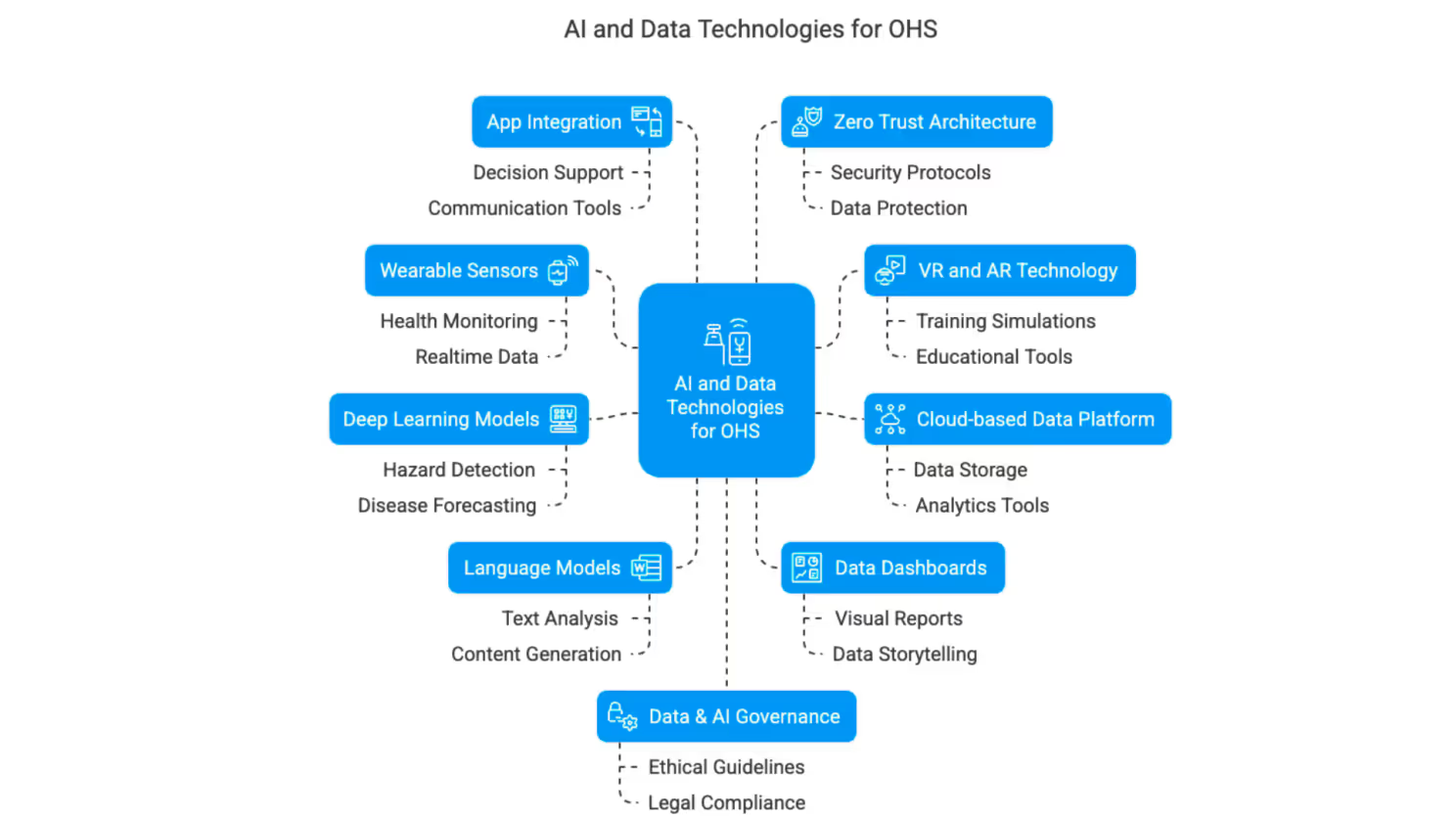How to integrate AI in occupational health & safety, safely and effectively
-11.avif)
First things first. Before we can talk about integrating Artificial Intelligence (AI) into occupational health and safety (OHS), corporate wellness, and industrial hygiene, let's make sure we are clear on what we mean by AI. The most practical and useful definition is the suite of technologies that collect, process, analyse, communicate and act on information in an automated, scalable, secure and ethical way, as shown in the image below.

The integration of Artificial Intelligence (AI) into occupational health and safety (OHS), corporate wellness, and industrial hygiene within the mining, oil, and gas sectors presents significant opportunities for enhancing worker safety, lowering the burden of occupational diseases, and improving operational efficiency. However, several barriers impede the widespread adoption of AI in these high-risk industries. The top four barriers are:
- Data Privacy and Ethical Concerns
- High Implementation Costs and Infrastructure Challenges
- Workforce Resistance and Skills Gaps
- Lack of Transparency and Explainability in AI Systems
-9.png)
1. Data Privacy and Ethical Concerns
Inevitably, AI systems will require access to sensitive employee data, including health records and real-time monitoring information. This raises significant ethical and legal concerns, particularly regarding compliance with data protection regulations such as EU's GDPR, Saudi Arabia's Personal Data Protection Law, and South Africa's Protection of Personal Information Act. The ethical and legal challenge intensifies when considering the balance between leveraging data for safety improvements and respecting individual privacy rights. For instance, the use of AI to predict occupational hearing loss among mineworkers has highlighted tensions between data utility and confidentiality. To overcome these challenges, organisations must establish robust data governance frameworks that ensure transparency, obtain informed consent, and implement stringent data security measures. Guidance and oversight from legal experts, cybersecurity experts and ethicists during the entire process from design to testing and rollout is key to ensure that any new AI application is aligned with all internal and external ethical standards and legal requirements.
2. High Implementation Costs and Infrastructure Challenges
Deploying AI technologies in OHS and industrial hygiene is capital-intensive, requiring substantial investments in hardware, software, and skilled personnel. Many companies, especially smaller ones, may find these costs prohibitive. These challenges are compounded in remote or underdeveloped regions where mining and oil extraction often occur. To mitigate these barriers, companies can use phased implementation strategies, starting with pilot projects to demonstrate value and scalability. Focusing on "Proof of Value" and demonstrating high return on investment early in the implementation is important to secure buy-in and gain company-wide momentum for new AI integrations. Moreover, investing in modular and scalable AI solutions allows organisations to adapt to evolving needs without incurring prohibitive upfront expenses. In my experience, the return on investment is highest when AI applications are introduced after securing a strong foundation of data governance, data infrastructure and realtime data dashboards.
3. Workforce Resistance and Skills Gaps
The introduction of AI into the workplace can lead to apprehension among employees, stemming from fears of job displacement and increased surveillance. This resistance is often fuelled by a lack of understanding of AI technologies and their implications. Furthermore, the existing workforce may lack the necessary skills to interact effectively with AI systems, creating a skills gap that hinders adoption. Addressing these issues requires comprehensive change management strategies that include transparent communication about the role of AI, its benefits, and its limitations. Investing in training programmes empowers employees to work alongside AI, enhancing their capabilities and reducing fear. Engaging employees in the development and implementation process can also foster a sense of ownership and acceptance, facilitating a deeper appreciation for the importance of high quality input data and ultimately a smoother and more valuable integration of AI technologies.
4. Lack of Transparency and Explainability in AI Systems
AI systems, particularly those utilising complex algorithms like deep learning and language models, often operate as black boxes, making it difficult to understand how decisions are made. This opacity can lead to mistrust among users and stakeholders, especially when AI outputs have significant implications for worker safety and health. The inability to explain AI decisions also poses challenges for accountability and compliance with regulatory standards. To overcome this barrier, organisations should prioritise the development and deployment of explainable AI (XAI) models that provide clear insights into decision-making processes. Implementing user-friendly interfaces that present AI findings in an understandable manner can enhance transparency. Additionally, establishing protocols for human oversight ensures that AI recommendations are reviewed and validated by qualified personnel, maintaining accountability and building trust in AI systems.
Conclusion
The adoption of AI in occupational health and safety, corporate wellness, and industrial hygiene within the mining, oil, and gas sectors has been sluggish due to a confluence of ethical, financial, cultural, and technical barriers. Data privacy concerns, high implementation costs, workforce resistance, and the opaque nature of AI systems collectively impede progress. However, these challenges are not insurmountable. By establishing robust data governance frameworks, adopting scalable implementation strategies, investing in continuous professional development around data and tech fluency, and ensuring transparency in AI operations, organisations can integrate AI safely and effectively. Interdisciplinary collaboration between industry experts, AI service providers, and experts in cybersecurity, ethics and legal compliance is essential to create an environment conducive to AI adoption, ultimately enhancing safety, health, and well-being in these high-risk industries.

-6.png)
-5.png)
-13.avif)